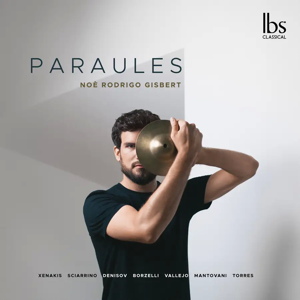
Paraules
Noè Rodrigo Gisbert (percussion)
rec. 2022, Auditorio Manuel de Falla, Granada, Spain
IBS Classical IBS142023 [69]
A solo recital by a percussionist is not the kind of thing I come across every day, so I was intrigued to receive this for review. Noè Rodrigo Gisbert is Spanish, is now based in Amsterdam and has played all over Europe. This is his first recording; its title means words, or possibly proverbs. His recital is of seven works, each by a different composer. It is only relatively recently that percussion instruments have been given equal status to strings and wind in Western art music, though of course in other traditions, such as those of Africa and East Asia, they have a long history. In the West we had occasional tours de force, such as Wagner’s anvils, Stravinsky’s drum parts in the Rite of Spring, Varèse’s Ionisation and the percussion variation in Britten’s Young Person’s Guide, but I would date the full acceptance of percussion to Messiaen’s Turangalîla-Symphonie of 1948. Solo works came a bit later. There is now a considerable number and in fact there are several solo percussion recitals to set alongside this one.
I divide percussion instruments into roughly two groups: those with definite pitch, such as timpani, bells and hammer instruments such as the xylophone and marimba, and instruments of indefinite pitch, such as the side and bass drums, gongs and tam-tams, triangle, wood blocks, castanets and so on. Percussionists must be able to play all of these, so they must be versatile! Most of the works here use at least one hammer instrument, while some use unpitched instruments as well.
We begin with the oldest work here, Xenakis’ Psappha of 1957. This is written for three groups of instruments, three of wood or skins and three of metal. The exact timbre is not important. The score is unusual, being in graphic rather than the usual staff notation. It begins with a regular beat with irregular accents, interrupted by a faster passage at a higher pitch. Then the higher pitched material then takes over. A kind of dialogue ensues which ends with a crash on a deep low drum.
Sciarrino’s Il legno e la parole (the wood and the word) is for solo marimba. I find this such a beguiling instrument that I can enjoy almost anything written for it. This is a playful work, full of twiddles, arabesques and fast repeated notes.
Denisov’s Schwarze Wolken (black clouds) is for solo vibraphone. This is a more obviously modernist work. It seems to be based on a sequence of four chords which are repeated, decorated and embellished. Vibraphone notes have a long resonance unless deliberately damped and Denisov here sometimes allows them to build up to quite a jangle.
Borzelli’s Wooden is for marimba, log drum and woodblock. It begins with rattling sounds with intermittent interjections. Eventually this develops into a kind of dance which eventually fades and the work ends with rattles again. I think this must be more interesting to play than I found it to listen to.
Vallejo’s Tactus is based on a tongue twister used by children in Tanzania. It is written for a group of small drums, tomtoms I think, on which the composer sets up rhythmic patterns. The work builds up, then sinks down to nothing before starting again for a brief coda.
Mantovani’s Moi, jeu… is another work for solo marimba. This is much more aggressive than Sciarrino’s piece we had earlier, with runs, flourishes and sudden loud accents, but I felt this was going rather against the nature of the instrument, which I think of as basically a gentle one.
Tiento by Torres is for both marimba and vibraphone, but they are not, I think, sounded together. This begins as a playful dancing piece in something like sonata form on the marimba, but then there is a jump to a radiant passage on the vibraphone. After this we return to the marimba. This is a subtle and rewarding work.
Throughout this recital Gisbert is in absolute command of all his instruments. His technique is as secure on the hammer instruments as on the drums and woodblocks. With percussion you also have to ask if the instruments themselves are well chosen, with an appropriate timbre and the right kind of mallet or beater. Here they certainly are. Furthermore, the recording is excellent, with the right degree of distance and resonance to help the instruments sound their best. I found the booklet rather opaque but that is of little moment. This will appeal to the adventurous.
Stephen Barber
Help us financially by purchasing from


Contents
Iannis Xenakis (1922-2001)
Psappha (1975)
Salvatore Sciarrino (b. 1947)
Il legno e la parola (2004)
Edison Denisov (1929-1996)
Schwarze Wolken (1984)
Silvia Borzelli (b. 1978)
Wooden (2015)
Polo Vallejo (b. 1959)
Tactus (2005-6)
Bruno Mantovani (b. 1974)
Moi, jeu… (1998)
Jesús Torres (b. 1954)
Tiento (1937)

















